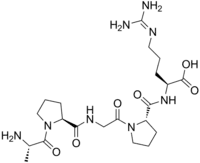Enterostatin
 | |
| Names | |
|---|---|
| IUPAC name
(2S)-2-[[(2S)-1-[2-[[(2S)-1-[(2S)-2-aminopropanoyl]pyrrolidine-2-carbonyl]amino]acetyl]pyrrolidine-2-carbonyl]amino]-5-(diaminomethylideneamino)pentanoic acid | |
| Other names
Procolipase activation peptide; APGPR; L-Alanyl-L-prolylglycyl-L-prolyl-L-arginine | |
| Identifiers | |
CAS Number |
|
3D model (JSmol) |
|
| ChemSpider | |
PubChem CID |
|
| UNII | |
CompTox Dashboard (EPA) |
|
InChI
| |
SMILES
| |
| Properties | |
Chemical formula |
C21H36N8O6 |
| Molar mass | 496.569 g·mol−1 |
Except where otherwise noted, data are given for materials in their standard state (at 25 °C [77 °F], 100 kPa). | |
| Infobox references | |
Enterostatin is a pentapeptide[1] derived from a proenzyme in the gastrointestinal tract called procolipase. It reduces food intake, in particular fat intake,[2] when given peripherally or into the brain.[3]
Function
Enterostatin is created in the intestine by pancreatic procolipase, the other colipase serving as an obligatory cofactor for pancreatic lipase during fat digestion. Enterostatin can be created in the gastric mucosa and the mucosal epithelia in the small intestine. An increased high fat diets will cause the procolipase gene transcription and enterostatin to release into the gastrointestinal lumen. Enterostatin appears in the lymph and circulation after a meal. Enterostatin has been shown to selectively reduce fat intake during a normal meal. The testing has been successful with different species.
Signaling pathway
The signaling pathway of the peripheral mechanism uses afferent vagal to hypothalamic centers. The central responses are mediated through a pathway including serotonergic and opioidergic components. Inveterately, enterostatin cuts fat intake, bodyweight, and body fat. This reaction may involve multiple metabolic effects of enterostatin, which include a decrease of insulin secretion,[4] a growth in sympathetic drive to brown adipose tissue, and the stimulation of adrenal corticosteroid secretion. A possible pathophysiological role is indicated by studies that have associated low enterostatin output and/or responsiveness to breeds of rat that become obese and prefer dietary fat. Humans with obesity also exhibit a lower secretion from pancreatic procolipase after a test meal, compared with persons of normal weight.[3]
Effects
Its effects include a reduction of insulin secretion, an increase in sympathetic drive to brown adipose tissue, and the stimulation of adrenal corticosteroid secretion. At the end level, it initiates a sensation of fullness of stomach which could be the reason for its role in regulation of fat intake and reduction of body weight. For enterostatin to be utilized it needs the presence of CCK A receptors. Studies based on rats who lack these receptors have found them to be un-responsive to enterostatin.[5]
When rats have been injected with high doses of enterostatin into the brain the rats ate progressively less food as the dose was increased.[6]: 969 In rats, examination of experiments involving the effects of peripheral or intracerebroventricular administration of enterostatin show this selectively slows down fat consumption.[7]: 8
Medical trials
Although enterostatin-like immunoreactivities exist in blood, brain, and gut, and exogenous enterostatins decrease fat appetite and insulin secretion in rats, the roles of these peptides in human obesity remain to be examined.,[8]
References
- ↑ York DA, Teng L, Park-York M (June 2010). "Effects of dietary fat and enterostatin on dopamine and 5-hydroxytrytamine release from rat striatal slices". Brain Res. 1349: 48–55. doi:10.1016/j.brainres.2010.06.036. PMID 20599830.
- ↑ Fernstrom, etc; John D. Fernstrom; Ricardo Uauy; Pedro Arroyo (2000). Nutrition and Brain: 5th Nestle Nutrition Workshop, Mexico City. Karger Publishers. p. 76. ISBN 978-3-8055-7166-1.
- 1 2 Erlanson-Albertsson, C; York, D (July 1997). "Enterostatin--a peptide regulating fat intake". Obesity Research. Nature Publishing Group. 5 (4): 360–72. doi:10.1002/j.1550-8528.1997.tb00565.x. ISSN 1930-7381. PMID 9285845.
- ↑ Park M, Farrell J, Lemmon K, York DA (October 2009). "Enterostatin alters protein trafficking to inhibit insulin secretion in Beta-TC6 cells". Peptides. 30 (10): 1866–73. doi:10.1016/j.peptides.2009.06.021. PMC 2755607. PMID 19563849.
- ↑ Jean-Pierre Montmayeur, Johannes le Coutre (September 14, 2009). Fat Detection: Taste, Texture, and Post Ingestive Effects. CRC Press; 1 edition. p. 359. ISBN 978-1-4200-6775-0.
{{cite book}}: CS1 maint: uses authors parameter (link) - ↑ Handbook of biologically active peptides. Londan: Academic Press. 2006. ISBN 978-0-12-369442-3.
- ↑ George A. Bray, Donna H. Ryan (2006). Overweight and the Metabolic Syndrome: From Bench to Bedside. Springer; 1 edition. ISBN 978-0-387-32163-9.
{{cite book}}: CS1 maint: uses authors parameter (link) - ↑ C. Prasad, M. Imamura, C. Debata, F. Svec, N. Sumar and J. Hermon-Taylor (1999). Hyperenterostatinemia in Premenopausal Obese Women. The Journal of Clinical Endocrinology & Metabolism Vol. 84, No. 3 937-941.
{{cite book}}: CS1 maint: uses authors parameter (link)